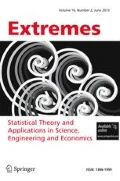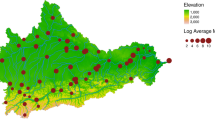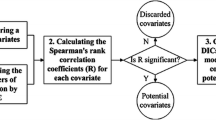Abstract
Estimation of flood and drought frequencies is important for reservoir design and management, river pollution, ecology and drinking water supply. Through an example based on daily streamflow observations, we introduce a stepwise procedure for estimating quantiles of the hydrological extremes floods and droughts. We fit the generalised extreme value (GEV) distribution by the method of block maxima and the generalised Pareto (GP) distribution by applying the peak over threshold method. Maximum likelihood, penalized maximum likelihood and probability weighted moments are used for parameter estimation. We incorporate trends and seasonal variation in the models instead of splitting the data, and investigate how the observed number of extreme events, the chosen statistical model, and the parameter estimation method effect parameter estimates and quantiles. We find that a seasonal variation should be included in the GEV distribution fitting for floods using block sizes less than one year. When modelling droughts, block sizes of one year or less are not recommended as significant model bias becomes visible. We conclude that the different characteristics of floods and droughts influence the choices made in the extreme value modelling within a common inferential strategy.
Similar content being viewed by others
References
Aune, B., Air temperature normals, normal period 1961–90, Climate Report No. 02/93, the Norwegian Meteorological Institute, DNMI, Norway, 1993.
Bobée, B. and Rasmussen, P.F., “Recent advances in flood frequency analysis,” Rev. Geophys. 33, 1111–1116, (1995).
Buishand, T.A., and Demaré, G.R., “Estimation of the annual maximum distribution from samples of maxima in separate season,” Stoch. Hydrol. Hydraul. 4, 89–103, (1990).
Clausen, B. and Pearson, C.P., “Regional frequency analysis of annual maximum streamflow drought,” J. Hydrol. 173, 11–130, (1995).
Coles, S.G., An Introduction to Statistical Modelling of Extreme Values, Springer, London, 2001.
Coles, S.G. and Casson, E., “Extreme value modelling of hurricane wind speed,” Struct. Saf. 20, 283–296, (1998).
Coles, S.G. and Dixon, M.J., “Likelihood-based inference for extreme value models,” Extremes 2(1), 5–23, (1999).
Coles, S., Pericchi, L.R. and Sisson S., “A fully probabilistic approach to extreme rainfall modelling,” J. Hydrol. 273, 35–50, (2003).
Cramér, H. and Leadbetter, M.R., Stationary and Related Stochastic Processes, John Wiley and Sons, New York, 1967.
Cunnane, C., “A note on the Poisson assumption in partial duration series model,” Water Resour. Res. 15(2), 489–494, (1979).
Davison, A.C. and Hinkley, D.V., Bootstrap Methods and Their Applications, Cambridge University Press, 1997.
Davison, A.C. and Smith, R.L., “Models for exceedances over high thresholds,” J. R. Stat. Soc., Ser. B 52(3), 393–443, (1990).
Dupuis, D.J., “Exceedances over high threshold: A guide to threshold selection,” Extremes 1(3), 251–261, (1998).
Efron, B. and Tibshirani, R.J., An Introduction to the Bootstrap, Monographs on Statistics and Applied Probability, Chapmann & Hall, New York, 57, 1998.
Embrects, P., Klüppenberg, C. and Mikosch, T., Modelling Extremal Events for Insurance and Finance, Springer, Berlin, 1999.
FEH, Flood Estimation Handbook, Institute of Hydrology, Wallingford, UK, 1999.
Fisher, R.A. and Tippet, L.H.C., “Limiting forms of the frequency distributions of the largest or smallest member of a sample,” Proc. Camb. Phil. Soc. 24, 180–190, (1928).
Frigessi, A., Haug, O. and Rue, H., “A dynamic mixture model for unsupervised tail estimation without threshold selection,” Extremes 5(3), 219ndash;235, (2002).
Førland, E., Precipitation Normals, Normal Period 1961–90. Climate Report No. 39/93, the Norwegian Meteorological Institute, DNMI, Norway, 1993.
Førland, E., Roald, L.A., Tveito, O.E., and Hanssen-Bauer, I., Past and Future Variations in Climate and Runoff in Norway. Climate Report No. 19/00, The Norwegian Meteorological Institute, DNMI, Norway, 2000.
GREHYS, “Presentation and review of some methods for regional flood frequency analysis,” J. Hydrol. 186, 63–84, (1996).
Heo, J.-H., Salas, J.D. and Boes, C.D., “Regional flood frequency analysis based on a Weibull model: Part 2. Simulations and applications,” J. Hydrol. 242, 171–182, (2001).
Hisdal, H., Stahl, K., Tallaksen, L.M. and Demuth, S., “Have streamflow droughts in Europe become more severe or frequent?” Int. J. Climatol. 21, 317–333, (2001).
Hosking, J.R.M. and Wallis, J.R. Regional Frequency Analysis, Cambridge University Press, Cambridge, 1997.
Hosking, J.R.M., Wallis, J.R. and Wood, E.F., “Estimation of the generalized extreme- value distribution by the method of probability-weighted moments,” Technometrics 27(3), 251–261, (1985).
Kjeldsen, T.R., Lundorf, A. and Rosbjerg, D., “Use of a two-component exponential distribution in partial duration modelling of hydrological droughts in Zimbabwean rivers,” Hydrol. Sci. J. 45(2), 285–298, (2000).
Klemeš, V., “Tall tales about tails of hydrological distributions. I,” J. Hydrol. Eng. 5(3), 227–231, (2000a).
Klemeš, V., “Tall tales about tails of hydrological distributions. II,” J. Hydrol. Eng. 5(3), 232–239, (2000b).
Lang, M., Ouarda, T.B.M.J. and Bobée, B., “Towards operational guidelines for over-threshold modeling,” J. Hydrol. 225(3–4), 103–117, (1999).
Leadbetter, M.R. and Rootzén, H., “Extremal theory for stochastic processes,” Ann. Probab. 16(2), 431–478, (1988).
Leadbetter, M.R., Lindgren, G. Rootzén, H., Extremes and Related Properties of Random Sequences and Processes, Springer, New York, 1983.
Madsen, H. and Rosbjerg, D., “A Regional Bayesian Method for Estimation of Extreme Streamflow Droughts,” in Statistical and Bayesian Methods in Hydrological Sciences (E. Parent, B. Bobeé, P. Hubert and J. Miquel, eds), Studies and Reports in Hydrology, UNESCO, Paris, France: 327–340, 1998.
Madsen, H., Pearson, C.P., Rasmussen, P.F. and Rosbjerg, D., “Comparison of annual maximum series and partial duration series methods for modelling extreme hydrological events 1. At-site modelling,” Water Resour. Res. 33(4), 747–758, (1997a).
Madsen, H., Pearson, C.P. and Rosbjerg, D., “Comparison of annual maximum series and partial duration series methods for modelling extreme hydrologic events 2. Regional modelling,” Water Resour. Res. 33(4), 759–769, (1997b).
Martins, E.S., and Stedinger, J.R., “Generalized maximum-likelihood generalized extreme-value quantile estimators for hydrologic data,” Water Resour. Res. 36(3), 737–744, (2000).
Martins, E.S., and Stedinger, J.R., “Generalized maximum likelihood Pareto-Poisson flood risk analysis for partial duration series,” Water Resour. Res. 37(10), 2551–2557, (2001).
Pettersson, L.-E., Fjelstad, K., Engen, T., Hydrometriske stasjoner for sanntidsdata. Vannføringsstatistikk og feltbeskrivelser. (Real time hydrometric stations. Flow statistics and catchment descriptions. In Norwegian), Publication No. 19, NVE, Oslo, Norway, 1996.
Pickands, J., “Statistical inference using extreme order statistics,” Ann. Stat. 3(1), 119–131, (1975).
Rasmussen, P. and Rosbjerg, D., “Prediction uncertainty in seasonal partial duration series.” Water Resour. Res. 27(11), 2875–2883, (1991).
Rice, S.O., “Mathematical analysis of random noise,” Bell Syst. Tech. J. 24, 46–156, (1945).
Rosbjerg, D., Madsen, H. and Rasmussen, P.F., “Prediction in partial duration series with generalized pareto distributed exceedances,” Water Resour. Res. 28(11), 3001–3010, (1992).
Rossi, F., Fiorentino, M. and Versace, P., “Two-component extreme value distribution for flood frequency analysis,” Water Resour. Res. 20(7), 847–856, (1984).
Rootzén, H. and Tajvidi, N., “Extreme value statistics and wind storm losses: A case study,” Scand. Actuar. J. 1, 70–94, (1997).
Smith, R.L., “Maximum likelihood estimation in a class of nonregular cases,” Biometrika 72, 69–90, (1985).
Smith, R.L., “Extreme value analysis of environmental time series: An application to trend detection in ground-level ozone,” Stat. Sci. 4(4), 367–377, (1989).
Stedinger, J.R., Vogel, R.M. and Foufoula-Georgiou, E., “Frequency Analysis of Extreme Events,” in Handbook of Hydrology (D.R. Maidment, ed), McGraw-Hill, New York, 18.41, 1993.
Strupczewski, W.G., Singh, V.P. and Feluch, W., “Non-stationarity approach to at-site flood frequency modelling I. Maximum likelihood estimation,” J. Hydrol. 248, 123–142, (2001).
Tallaksen, L.M., Streamflow drought frequency analysis, Contribution to report from Exploratory Workshop on Drought and Drought Mitigation in Europe, 1–3 March 1999, JCRR-Ispra (VA), Italy (to be published in the “Natural and Technological Hazards” series of Kluwer Academic Publishers), 2000.
Tallaksen, L.M. and Hisdal, H. “Regional analysis of extreme streamflow drought duration and deficit volume. In FRIEND’97 - Regional Hydrology: Concepts and Models for Sustainable Water Management,” IAHS 246, 141–150, (1997).
Tallaksen, L. M., Madsen, H. and Clausen, B., “On the definition and modelling of streamflow drought duration and deficit volume,” Hydrol. Sci. J. 42(1), 15–33, (1997).
Tate, E.L. and Freeman, S.N., “Three modelling approaches for seasonal streamflow droughts in southern Africa: The use of Censored data,” Hydrol. Sci. J. 45(1), 27–42, (2000).
Tawn, J.A.,“Estimating probabilities of extreme sea-levels,” App. Stat. 41, 77–93, (1992).
Todorovic, P. and Rouselle, J., “Some problems of flood analysis,” Water Resour. Res. 7(5), 1144–1150, (1971).
USWRC, Guidelines for determining flood flow frequency. United States Water Resources Council, Bull. 17, Hydrl. Comm. Washington, DC, 1976.
Vogel, R.M., McHahon, T.A. and Chiew, F.H.S., “Flood-flow frequency model selection in Australia,” J. Hydrol. 146, 421–449, (1993).
Waylen, P. and Woo, M.-K., “Prediction of annual floods generated by mixed processes,” Water Resour. Res. 18(4), 1283–1286, (1982).
Woo, M.-K. and Tarhule, A., “Streamflow droughts of northern Nigerian rivers,” Hydrol. Sci. J. 39(1), 19–34, (1994).
Yevjevich, V., An Objective Approach to Definition and Investigations of Continental Hydrologic Droughts, Hydrology Papers, Colorado State University, Fort Collins, 23, 1967.
Zaidman, M.D., Keller, V. Young, A.R. Cadman, D., “Flow-duration-frequency behaviour of British rivers based on annual minimum data,” J. Hydrol. 277, 195–213, (2003).
Zelenhasic, E. and Salvai, A., “A method of streamflow drought analysis.” Water Resour. Res. 23(1), 156–168, (1987).
Author information
Authors and Affiliations
Corresponding author
Rights and permissions
About this article
Cite this article
Engeland, K., Hisdal, H. & Frigessi, A. Practical Extreme Value Modelling of Hydrological Floods and Droughts: A Case Study. Extremes 7, 5–30 (2004). https://doi.org/10.1007/s10687-004-4727-5
Received:
Revised:
Accepted:
Published:
Issue Date:
DOI: https://doi.org/10.1007/s10687-004-4727-5




